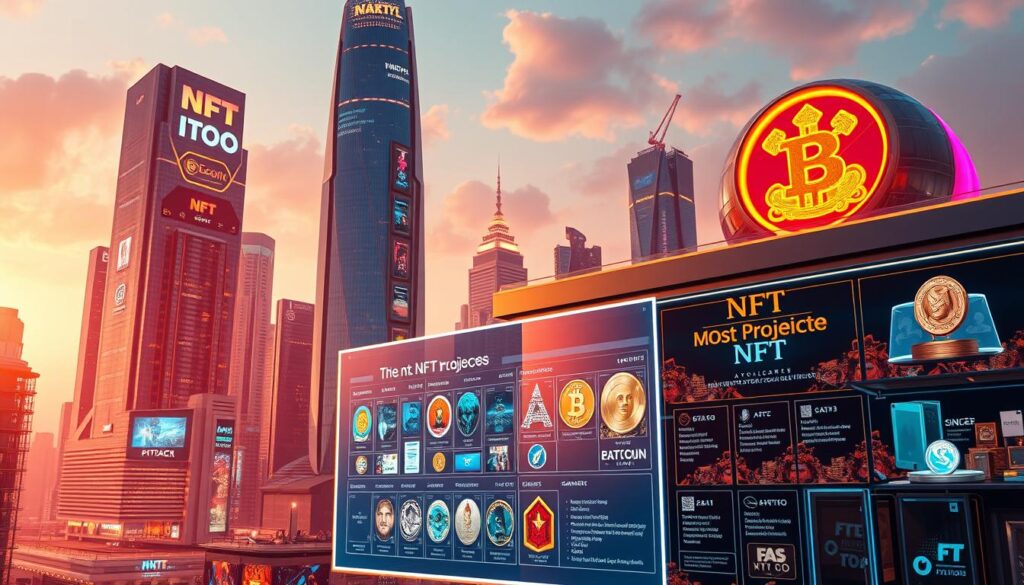Now Reading: Discover the Latest NFT Fashion Drops
- 01
Discover the Latest NFT Fashion Drops
Discover the Latest NFT Fashion Drops
Virtual worlds are redefining style. Platforms like Decentraland now attract over 8,000 daily visitors who collect and trade digital wearables. What started as basic gaming accessories has evolved into a $10 billion industry, with users treating virtual outfits as prized possessions.

People now spend hundreds—sometimes thousands—on outfits for their online avatars. These items aren’t just pixels; they’re status symbols. A digital handbag or jacket can signal taste and exclusivity, mirroring real-world luxury trends.
This shift has caught the attention of top-tier labels. Established houses and Web3 startups alike are racing to release limited-edition collections. The blend of scarcity and creativity drives demand, turning virtual storefronts into must-visit destinations.
Key Takeaways
- Metaverse platforms host thriving communities focused on digital style
- Virtual avatars now serve as customizable status markers
- Luxury labels are expanding into blockchain-based apparel
- Consumers invest heavily in exclusive digital collectibles
- Online identities increasingly influence purchasing decisions
The intersection of technology and self-expression is creating new opportunities. As physical and digital worlds merge, how we define “value” in clothing continues to evolve. This isn’t just a trend—it’s a cultural transformation reshaping retail.
Introduction to the NFT Fashion Landscape
Digital threads now weave through virtual closets, creating a new frontier for style enthusiasts. This emerging space combines artistry with cutting-edge tech, letting wearables become more than screen decorations.
Defining Fashion NFTs
Fashion NFTs are blockchain-secured tokens representing exclusive digital wearables. Unlike standard online images, these assets carry unique identifiers proving ownership. Each piece lives on decentralized networks, guarded by smart contracts that track transfers.

Overview of the Digital Fashion Revolution
Designers now craft intricate pieces impossible in physical form—glowing fabrics, morphing patterns, and gravity-defying silhouettes. Blockchain authentication solves counterfeiting issues, while programmable royalties let creators earn from resales.
Consumers collect these items for avatar customization or as tradeable art. Virtual jackets gain value through scarcity, mirroring luxury markets. Brands use this model to test bold concepts without material waste.
The shift extends beyond aesthetics. It redefines how people express identity online, turning profiles into curated galleries. As tech evolves, digital wardrobes may become as meaningful as physical ones.
The Rise of NFT Fashion: From Physical to Digital
Luxury houses are rewriting retail rules by merging tangible craftsmanship with blockchain innovation. This fusion creates hybrid assets that exist both in wardrobes and wallets, appealing to collectors who value exclusivity across dimensions.

Phygital NFTs and Their Market Impact
Dolce & Gabbana’s Collezione Genesi shattered expectations when nine digital-physical hybrids sold for $5.7 million. Each piece granted buyers a physical garment plus a blockchain certificate, proving digital ownership while maintaining real-world prestige.
Prada’s strategy reveals another angle. Their monthly Timecapsule releases require purchasing limited-edition shirts or sweaters to unlock matching virtual assets. This approach boosted engagement by 40% compared to standard launches, according to brand reports.
The model solves a critical challenge: skeptics gain something tactile, while brands expand revenue streams. One analysis shows phygital collections increase average order values by 22% compared to physical-only releases.
As more luxury players adopt this blueprint, they’re discovering unexpected benefits. Hybrid releases attract younger audiences without alienating traditional clients—a balance that could redefine how we perceive value in the market for decades.
Innovative Uses of Blockchain in Fashion
Blockchain stitches trust into every thread of modern design. Forward-thinking labels now deploy this technology to solve age-old industry challenges while creating new value streams.

Enhancing Authenticity and Consumer Trust
Tod’s recent Di Bag launch demonstrates how brands combat counterfeiting. Each custom piece carries a digital passport via LVMH’s Aura Blockchain. Buyers receive twin tokens: one verifying authenticity, another serving as a tradeable asset.
This system addresses a $30 billion counterfeit problem. Consumers scan NFC chips in products like Mugler’s Spiral Curve bags to instantly confirm origins. Permanent blockchain records make fraud nearly impossible.
Leveraging Blockchain for Exclusive Access
Ownership unlocks become seamless with distributed ledgers. Limited-edition physical items now ship with digital keys granting entry to VIP experiences. Balenciaga’s recent sneaker line used this method, boosting secondary market values by 65%.
Digital Product Passports in Action
EU regulations will soon require detailed production histories. Early adopters like Tod’s store materials data and craftsmanship details on-chain. This transparency builds loyalty while streamlining compliance.
As one executive noted: “These passports transform items into living stories.” Brands gain insights into usage patterns, while buyers access repair histories and resale tools – all through bulletproof verification systems.
Latest NFT Fashion Drops: Curated Trends and Releases
Luxury labels are crafting digital heirlooms through blockchain-powered releases. These limited-edition items blend cutting-edge tech with legacy craftsmanship, creating new benchmarks for exclusivity.
Spotlight on Luxury Fashion Brands
Louis Vuitton redefined high-value collectibles with their Via project. The €39,000 Treasure Trunks unlocked elite experiences, while November’s miniature trunk NFTs sold out in 23 minutes. Their Discord channels for holders boosted engagement by 70%, proving the power of loyalty ecosystems.
Gucci partnered with Christie’s to auction AI-generated art pieces. Their July collection fetched 4x estimates, merging algorithmic creativity with blockchain authentication. This strategy positions digital wearables as tradable art assets.
Successful Case Studies and Market Trends
Prada’s Timecapsule series demonstrates consistency’s value. Monthly releases since 2022 built a 150,000-member Crypted Discord community. Members gain early access to physical drops—a model copied by three competitors this year.
Nike’s Rtfkt division dominates hybrid releases. December’s NFC-tagged Dunk sneakers sold 8,000 units in 90 seconds. Their approach proves physical-digital bundles drive urgency, with resale values climbing 48% post-launch.
The market now rewards brands offering layered benefits. As one analyst noted: “It’s no longer about single transactions—it’s about cultivating tribes through tech-enabled exclusivity.”
Merging Tech and Creativity: Virtual Fashion Experiences
Digital craftsmanship meets algorithmic innovation as designers reimagine self-expression. Advanced tools now let creators blend code with couture, producing wearables that respond to user interactions and environments.
Integrating AI and Gaming in Style
Gucci’s partnership with Christie’s revealed how machines enhance human artistry. Their generative AI project produced 1,500 unique digital patterns in 72 hours—each verified on-chain. Holders of these pieces gained exclusive access to The Otherside, where avatars showcase collectibles in multiplayer quests.
Balenciaga’s November release transformed basic apparel into media hubs. Scanning their NFC-tagged hoodies unlocks encrypted playlists from Archive—a fusion of tactile clothing and digital rewards. This approach increased customer retention by 33% compared to standard merch drops.
- Gamified loyalty programs with tiered achievement systems
- AR filters that overlay digital accessories on physical outfits
- Cross-platform interoperability for metaverse assets
Emerging platforms let users test digital outfits through VR mirrors before purchase. As industry reports show, these hybrid models reduce return rates by 28% while boosting engagement.
Artists and engineers now co-create limited series that evolve based on owner interactions. One experimental jacket changes textures when near other collectors’ items—proving that in the metaverse, style becomes a living conversation.
Lessons Learned from Recent NFT Initiatives
Major labels are rewriting playbooks by focusing on sustained value over flashy campaigns. Since 2022, forward-thinking companies have shifted from single releases to building ecosystems that reward ongoing participation.
Long-term Utility Trends from Major Brands
Pioneers like Prada demonstrate how recurring benefits drive loyalty. Their Timecapsule series links physical purchases to digital perks, creating layered incentives. Holders gain early access to future drops and exclusive events, turning buyers into long-term stakeholders.
Consumer Engagement and Community Building
Successful strategies now prioritize interactive spaces over static transactions. Brands host virtual meetups where consumers co-create designs or vote on upcoming releases. These forums deepen connections while gathering real-time feedback.
Loyalty programs now use tiered rewards tied to participation metrics. Active community members unlock special content or real-world experiences. This approach boosts engagement by 58% compared to traditional marketing, according to recent industry reports.
By blending utility with genuine interaction, companies forge lasting relationships. The future belongs to brands that treat customers as collaborators rather than one-time buyers.
FAQ
How do blockchain-based products enhance authenticity for luxury items?
Blockchain technology creates immutable records for items like handbags or apparel, ensuring proof of origin and ownership. Brands like Louis Vuitton use this to combat counterfeits and build consumer trust through transparent supply chains.
What are "phygital" assets, and why are brands adopting them?
Phygital assets combine physical products with digital twins, often linked to exclusive perks. For example, Prada’s recent initiative paired limited-edition accessories with virtual collectibles, offering holders access to events or future drops.
How do digital passports work for apparel and accessories?
Digital passports store a product’s lifecycle data—such as materials, repairs, or resales—on the blockchain. Companies like Gucci have tested this to boost sustainability efforts and provide buyers with verifiable ownership histories.
Which luxury labels are leading in virtual experiences?
Balenciaga and Burberry have partnered with gaming platforms to launch wearable skins, while Dolce & Gabbana hosted metaverse showcases. These projects blend creativity with tech to engage younger, digitally-native audiences.
How do exclusive releases drive consumer engagement?
Limited-edition drops, like Louis Vuitton’s post-purchase NFT rewards, create urgency and loyalty. Brands leverage scarcity and tiered access to foster community interaction and repeat purchases.
What role does AI play in designing digital collections?
Tools like generative AI allow designers to prototype avant-garde styles quickly. For instance, Coperni used algorithms to craft virtual garments showcased in interactive runway events, merging art with cutting-edge tech.
Why are brands prioritizing long-term utility for holders?
Projects like Adidas’ “Into the Metaverse” offer ongoing benefits, including merch discounts or IRL event invites. This strategy shifts focus from speculative trading to sustained brand relationships and value.















